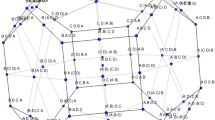Abstract
In this paper we propose a preference aggregation procedure for those cases in which the decision-makers express their preferences by means of a ranking of alternatives. Among the most applied methods for this purpose are those inspired by the Borda–Kendall rule, which attach to each alternative an aggregated value of the votes received in the different rank positions, and those based on distance measures between individual and collective preferences, which look for the solution that maximizes the consensus. The main idea here is to integrate these two approaches. Taking into account that the information about the values of weights or utilities assigned to each rank position is imprecise, we propose an evaluation of the alternatives using that vector of weights that minimizes the disagreement between DMs. In order to solve the problem, mixed-integer linear programming models are constructed. Two numerical examples are examined to illustrate the applicability of the proposed procedure.
Similar content being viewed by others
References
Ali I, Cook WD, Kress M et al (1986) Ordinal ranking with intensity of preference: a linear programming approach. Manage Sci 32(12): 1642–1647
Baigent N (2000) Preference proximity and anonymous social choice. Q J Econ 102(1): 161–169
Black D (1976) Partial justification of the Borda count. Public Choice 28(1): 1–15
Borda JC (1784) Mémoire sur les élections au scrutin. Histoire de l’Académie Royale des Sciences
Chebotarev PY, Shamis E (1998) Characterizations of scoring methods for preference aggregation. Ann Oper Res 80: 299–332
Contreras I, Hinojosa MA, Mármol AM (2005) A class of flexible weight indices for ranking alternatives. IMA J Manage Math 16(1): 71–85
Cook WD, Kress M (1985) Ordinal ranking with intensity of preference. Manage Sci 31(1): 26–32
Cook WD, Kress M (1986) Ordinal ranking and preference strength. Math Soc Sci 11: 295–306
Cook WD, Kress M (1990) A data envelopment model for aggregation preference ranking. Manage Sci 36(11): 1302–1310
Cook WD, Kress M (1996) An extreme-point approach for obtaining weighted ratings in qualitative multicriteria decision making. Nav Res Logis 43(4): 519–531
Cook WD, Seiford LM (1978) Priority ranking and consensus formation. Manage Sci 24(16): 1721–1732
Cook WD, Seiford LM (1982) On the Borda–Kendall consensus method for priority ranking problems. Manage Sci 28(6): 621–637
Cook WD, Kress M, Seiford LM (1997) A general framework for distance-based consensus in ordinal ranking models. Eur J Oper Res 96(2): 392–397
Fishburn PC (1977) Condorcet social choice functions. SIAM J Appl Math 33(3): 469–489
Foroguchi AA, Tamiz M (2005) An effective total ranking model for ranked voting system. Omega 33(6): 491–496
García-Lapresta JL (2007) Weighting individual opinions in group decision models. In: Modelling decisions in artificial intelligence. Lecture notes in artificial intelligence, vol 4617. Springer-Verlag, Berlin, pp 92–103
González-Pachón J, Romero C (1999) Distanced based consensus methods: a goal programming approach. Omega 27(3): 341–347
González-Pachón J, Romero C (2001) Aggregation of partial ordinal rankings: an interval goal programming approach. Comput Oper Res 28(8): 827–834
Hashimoto AA (1997) A ranked voting system using a DEA/AR exclusion model: a note. Eur J Oper Res 97(3): 600–604
Hwang CY, Lin MJ (1987) Group decision making under multiple criteria. Springer Verlag, Berlin
Kemeny J (1959) Mathematics without numbers. Daedalus 88: 571–591
Kemeny JG, Snell LJ (1962) Preference ranking: an axiomatic approach. In: Mathematical models in the social choice sciences. Ginn, New York, pp 9–23
Kendall M (1962) Rank correlation methods. Hafner, New York
Klamler C, Eckert D, Mitlöhner J, Schlötterer C (2000) A distance based comparison of basic voting rules. Cent Eur J Oper Res 14(4): 377–386
Nurmi H (2004) A comparison of some distance-based choice rules in ranking environments. Theory Decis 57: 5–24
Obata T, Ishii H (2003) A method for discriminating efficient candidates with ranked voting data. Eur J Oper Res 151(1): 233–237
Saari D, Merlin V (2000) A geometric examination of Kemeny’s rule. Soc Choice Welfare 17: 403–438
Wang YM, Yang JB, Xu DL (2005) A preference aggregation method through the estimation of utility intervals. Comput Oper Res 32(8): 2027–2049
Wang YM, Chin KS, Yang JB (2006) Three new models for preference voting and aggregation. J Oper Res Soc 58: 1389–1393
Young HP (1975) Social choice scoring functions. SIAM J Appl Math 28(4): 824–838
Author information
Authors and Affiliations
Corresponding author
Rights and permissions
About this article
Cite this article
Contreras, I. A Distance-Based Consensus Model with Flexible Choice of Rank-Position Weights. Group Decis Negot 19, 441–456 (2010). https://doi.org/10.1007/s10726-008-9127-9
Received:
Accepted:
Published:
Issue Date:
DOI: https://doi.org/10.1007/s10726-008-9127-9




